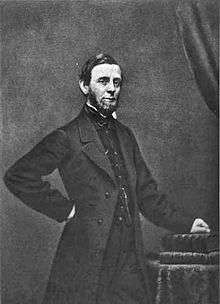George Palmer Putnam
| George Palmer Putnam | |
|---|---|
 George Palmer Putnam | |
| Born |
February 7, 1814 Brunswick, Maine, U.S. |
| Died | December 20, 1872 (aged 58) |
| Nationality | American |
| Citizenship | American |
| Occupation | publisher, author |
| Known for |
Wiley & Putnam G. Putnam Broadway Putnam's Magazine |
| Spouse(s) | Victorine Haven |
| Children |
11, including Mary Corinna Putnam (1842–1906) George Haven Putnam (1844–1930) John Bishop Putnam (1849–1915) Irving Putnam (1852–1931) Herbert Putnam (1861–1955) |
George Palmer Putnam (February 7, 1814 – December 20, 1872) was an important American book publisher.
Biography

Putnam was born in Brunswick, Maine. On moving to New York City, Putnam was given his first job by Jonathan Leavitt, who subsequently published Putnam's first book. In 1838, George Palmer Putnam and John Wiley established the publishing house of Wiley & Putnam in New York City. In 1841, Putnam went to London, UK where he set up a branch office, the first American to ever do so. In 1848 he returned to New York where he dissolved the partnership with John Wiley and established G. Putnam Broadway, publishing a variety of works including quality illustrated books.

In 1852, with the assistance of George William Curtis and other partners, he founded Putnam's Magazine. It operated until 1856, resumed in 1868, and finally merged with Scribner's Monthly.[1] His company was the official publisher to the 1853 New York World's Fair.
George Putnam published the books of many classic American authors including his close friend Washington Irving, William Cullen Bryant, James Fenimore Cooper, and Edgar Allan Poe. He served as secretary for the Publishers' Association for many years and was an advocate of the creation of International Copyright Law. During the American Civil War, he participated in the Loyal Publication Society of New York, and suspended his business for three years (1863–1866) to become the United States government's Collector of Internal Revenue in New York City.[2]
An important member of the New York artistic community, Putnam was the leading publisher of art books in his time and became one of the founders of the Metropolitan Museum of Art and served as honorary superintendent in 1872. He was also chairman of the Committee on Art at the Vienna Universal Exposition. He is believed to have been the first publisher to offer "royalties" to authors like Elizabeth Barrett Browning and Thomas Carlyle.[2][3]
Family
George Putnam married Victorine Haven. Their daughter, Mary Corinna Putnam (1842–1906) was a pioneering female doctor, the first woman admitted to the Faculté de Médecine de Paris. One of their sons, Herbert Putnam (1861–1955), became a noted librarian who served as the United States Librarian of Congress.
On Putnam's death in 1872 his sons George and John inherited the business and the firm's name was changed to G. P. Putnam's Sons. George Putnam published his father's memoirs in 1912 and in 2000, his life's story was told again under the title George Palmer Putnam — Representative American Publisher by Ezra Greenspan, Associate Professor of English at the University of South Carolina.
George Palmer Putnam's grandson and namesake, George P. Putnam (1887–1950), was part of the family business but was also an author and explorer who was married to the famous aviatrix Amelia Earhart.[4] His granddaughter Brenda Putnam was a well-respected sculptor and author.
Works
- Chronology, or an Introduction and Index to Universal History, Biography, and Useful Knowledge (1833)
- A Plea for International Copyright (1837)
- The Tourists in Europe (1838)
- American Book Circular with Notes and Statistics (1843)
- American Facts, Notes and Statistics Relative to the Government of the United States (1845)
- The World's Progress — a Dictionary of Dates (1850)
- Ten Years of the World's Progress, a supplement to his 1850 work (1861)
References
- ↑
 Rines, George Edwin, ed. (1920). "Putnam, George Palmer". Encyclopedia Americana.
Rines, George Edwin, ed. (1920). "Putnam, George Palmer". Encyclopedia Americana. - 1 2
 Gilman, D. C.; Peck, H. T.; Colby, F. M., eds. (1905). "Putnam, George Palmer". New International Encyclopedia (1st ed.). New York: Dodd, Mead.
Gilman, D. C.; Peck, H. T.; Colby, F. M., eds. (1905). "Putnam, George Palmer". New International Encyclopedia (1st ed.). New York: Dodd, Mead. - ↑ Lehmann-Haupt, Hellmut. The Book in America: A History of the Making and Selling of Books in the United States. New York City: R. R. Bowker Co., 1951. ISBN p. 112
- ↑ Herrmann, Anne "On Amelia Earhart: The Aviatrix as American Dandy" Ann Arnbor, MI:The Michigan Quarterly Review Volume XXXIX, Issue 1, Winter 2000
External links
| Wikimedia Commons has media related to George Palmer Putnam. |
-
 "Putnam, George Palmer". Collier's New Encyclopedia. 1921.
"Putnam, George Palmer". Collier's New Encyclopedia. 1921. -
 Fiske, John (1900). "Putnam, Israel". Appletons' Cyclopædia of American Biography.
Fiske, John (1900). "Putnam, Israel". Appletons' Cyclopædia of American Biography.